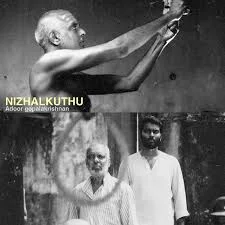NIZHALKUTHU 2002
by
Adoor Gopalakrishnan
Who bears the sin of a hanging?
Why should any sin be accrued if the sentence is just?
How much is the culpability of a hangman, and to what an extent is the judge or the King responsible? How can anyone but the accused be held accountable for his karma?
The Malayalam film Nizhalkuthu (Shadow Kill) is based in the Travancore State of 1940s. It is made clear in the story that the Raja of Travancore used to keep a Hangman permanently in his appointment by granting him house and lands, and that he also used to pardon convicts at such times that they would be hanged before this correspondence reached the execution house, and could halt the executions.
Did the Raja gain absolution with these pardons? Was not the hangman performing nishkama karma anyway? Does detached action absolve one of payback, or only helps in overcoming the fear and anxiety attached to the deed. The hangman was just a medium to carry out the decision taken by law, and yet it was he, who ended up pulling the rope every time.
There had been no execution for long in Travancore. The previous one bore heavily on the conscience of the hangman as he felt that he had hanged someone who was not quite guilty. What if divine justice is meted out on factual evidence, without going into the context, quite like the earthly one? Does the scene in heaven play out like it does in modern courts where the police look for a scapegoat, the lawyers want conviction and the judge looks for disposal? For one observing from a distance, was not the hangman guilty of murdering a man in cold blood, and without any provocation? Does Yama go into the fine print? Do Chitraguptas testify properly and explain the details, or merely blurt out facts?
Alcohol, Kali worship and healing the sick kept him going, but the hangman found his own existence burdensome. The rope used in the previous hanging was handed over to the hangman, which he hung in his prayer room and used its burnt ash to heal the sick and dying. The rope on which a convict breathed his last was supposed to provide life to the ailing.
A hanging is announced in 1941. The hangman pleads that someone else be chosen since he is in a bad state. The King’s man scoffs at this talk of postponement or alternative arrangement. He orders the hangman to get his act together, and take the help of his son, if he so wished. The son was a Gandhian, opposed to capital punishment, but did accompany his father for the execution, there being no other choice.
Since it was expected that the convict would not able to sleep on his last night, the one responsible for pulling the noose was also not to sleep as traditional mark of respect. The hangman was quite feverish, drank a lot and begged to be excused from the job, or at least retire for the night. To keep him awake and engaged, one of the policeman narrates a story of a 13-year old girl, who was raped and murdered by her sister’s husband. An innocent boy, whom the victim had befriended, was found guilty. Even the father of the dead girl did not depose against his son-in-law because he had already lost one of his daughters, and did not want to make the other a widow. When it is dramatically revealed that it is this innocent boy who will hang the next day, the hangman breaks down completely and the responsibility falls on his son, the Gandhian. The son, despite his principles, completes the job. The pardon duly arrives after the deed is done. Who bears the sin- The son, or the father or the King? What about the actual perpetrator?
It cannot be gainsaid that there dwells inherent unjustness in certain punishments, which might be attributed to miscarriage or manipulation of justice. Capital punishment is the final sentence- it precludes the possibility of recall, or reopening of the case or correction of an error. No crime, despite confession, is said to be proved beyond doubt. It is the realisation of this finality that takes its toll upon those who are involved in carrying out the orders. A hangman dies a little every time he pulls the noose.
I have seen many great films on capital punishment- Paths of Glory, A Short Film on Killing, Dead Men Walking, The Green Mile, The Life of David Gale and sundry others. But with due respects to Kubrick, Kieslowski, Frank Darabont and Tim Robbins, it is Adoor Gopalakrishnan’s Nizhalkuthu that leaves me stumped. In merely 90 minutes of runtime, he brings out the irony of same rope’s ash being used as ameliorative, and the elements of contradiction and compulsion in the Gandhian son’s karma to the fore. Accompanied with beautiful camerawork, fine background score and relaxed narrative, the powerful plot throws many Dharmic questions as challenges!
Did the son of the hangman carry out the hanging because it was his duty, or his father’s responsibility, or merely to emphasize that many such executions could be farcical in nature? What other choice did he have ?
Note- 1.The film is available on Youtube, along with English subtitles.
2.The English title, Shadow Kill, is a reference to the play Nizhalkuthu Attakatha, which is inspired from Mahabharata. In the play, Kauravas hire a witch-hunter to kill Pandavas by stabbing their shadows, and deliberates upon the morality of that act of killing. The film does not make reference to this story.


Comments
Post a Comment